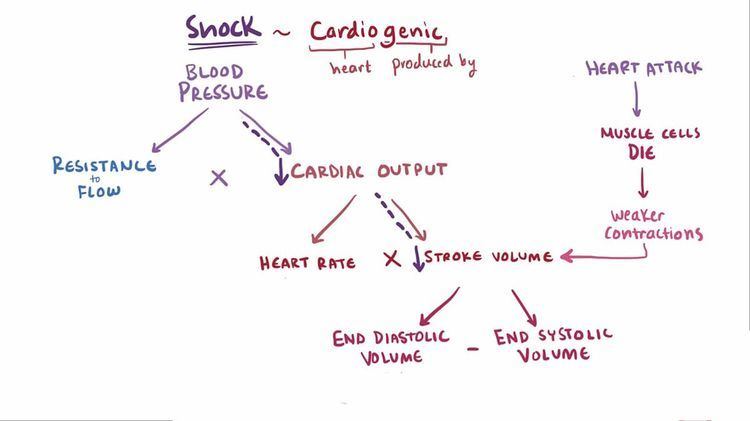ICD-10 R57.0 DiseasesDB 29216 eMedicine med/285 | ICD-9-CM 785.51 MedlinePlus 000185 MeSH D012770 | |
 | ||
Cardiogenic shock is a life-threatening medical condition resulting from an inadequate circulation of blood due to primary failure of the ventricles of the heart to function effectively.
Contents
- Signs and symptoms
- Causes
- Electrocardiogram
- Echocardiography
- Swan Ganz catheter
- Biopsy
- Treatment
- References
As this is a type of circulatory shock, there is insufficient perfusion of tissue to meet the demands for oxygen and nutrients. Cardiogenic shock is a largely irreversible condition and as such is more often fatal than not. The condition involves increasingly more pervasive cell death from oxygen starvation (hypoxia) and nutrient starvation (e.g. low blood sugar). Because of this, it may lead to cardiac arrest (or circulatory arrest), which is an abrupt stopping of cardiac pump function (as well as stopped respiration and a loss of consciousness).
Cardiogenic shock is defined by sustained low blood pressure with tissue hypoperfusion despite adequate left ventricular filling pressure. Signs of tissue hypoperfusion include low urine production (<30 mL/hour), cool extremities, and altered level of consciousness.
Treatment of cardiogenic shock depends on the cause. If cardiogenic shock is due to a heart attack, attempts to open the heart's arteries may help. An intra-aortic balloon pump or left ventricular assist device may improve matters until this can be done. Medications that improve the heart's ability to contract (positive inotropes) may help; however, it is unclear which is best. Norepinephrine may be better if the blood pressure is very low whereas dopamine or dobutamine may be more useful if only slightly low.
Signs and symptoms
Causes
Cardiogenic shock is caused by the failure of the heart to pump effectively. It can be due to damage to the heart muscle, most often from a large myocardial infarction. Other causes include abnormal heart rhythms, cardiomyopathy, cardiac valve problems, ventricular outflow obstruction (i.e. aortic valve stenosis, aortic dissection, cardiac tamponade, constrictive pericarditis, systolic anterior motion (SAM) in hypertrophic cardiomyopathy), or ventriculoseptal defects. It can also be caused by a sudden decompressurization (e.g. in an aircraft), where air bubbles are released into the bloodstream (Henry's Law), causing heart failure.
Electrocardiogram
An electrocardiogram helps establishing the exact diagnosis and guides treatment, it may reveal:
Echocardiography
Echocardiography may show poor ventricular function, signs of PED, rupture of the interventricular septum, an obstructed outflow tract or cardiomyopathy.
Swan-Ganz catheter
The Swan-Ganz catheter or pulmonary artery catheter may assist in the diagnosis by providing information on the hemodynamics.
Biopsy
When cardiomyopathy is suspected as the cause of cardiogenic shock, a biopsy of heart muscle may be needed to make a definite diagnosis.
Treatment
Depending on the type of cardiogenic shock, treatment involves infusion of fluids, or in shock refractory to fluids, inotropic medications. In case of an abnormal heart rhythm several anti-arrhythmic agents may be administered, e.g. adenosine.
Positive inotropic agents (such as dobutamine or milrinone), which enhance the heart's pumping capabilities, are used to improve the contractility and correct the low blood pressure. Should that not suffice an intra-aortic balloon pump (which reduces workload for the heart, and improves perfusion of the coronary arteries) or a left ventricular assist device (which augments the pump-function of the heart) can be considered. Finally, as a last resort, if the patient can be made stable enough and otherwise qualifies, cardiac transplantation can be performed. These invasive measures are important tools- more than 50% of patients who do not die immediately due to cardiac arrest from a lethal abnormal heart rhythm and live to reach the hospital (who have usually suffered a severe acute myocardial infarction, which in itself still has a relatively high mortality rate), die within the first 24 hours. The mortality rate for those still living at time of admission who suffer complications (among others, cardiac arrest or further abnormal heart rhythms, heart failure, cardiac tamponade, a ruptured or dissecting aneurysm, or another heart attack) from cardiogenic shock is even worse around 85%, especially without drastic measures such as ventricular assist devices or transplantation.
Cardiogenic shock may be treated with intravenous dobutamine, which acts on β1 receptors of the heart leading to increased contractility and heart rate.
